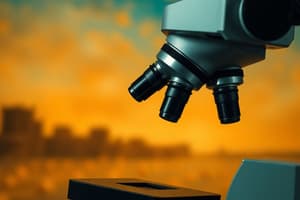Podcast
Questions and Answers
What is the function of the ocular lens?
What is the function of the ocular lens?
- Supports the nosepiece
- Eyepiece providing 10x magnification (correct)
- Contains mirrors to bend light
- Magnifies the specimen
What part of the microscope contains mirrors that bend light?
What part of the microscope contains mirrors that bend light?
Body
What is the function of the nosepiece in a compound microscope?
What is the function of the nosepiece in a compound microscope?
Mounts the objective lenses
What does the arm of a microscope do?
What does the arm of a microscope do?
What is the magnification range of the objective lenses?
What is the magnification range of the objective lenses?
What is the purpose of the mechanical stage?
What is the purpose of the mechanical stage?
What is the function of the course adjustment knob?
What is the function of the course adjustment knob?
What is the fine adjustment knob used for?
What is the fine adjustment knob used for?
What do the stage adjustment knobs do?
What do the stage adjustment knobs do?
What does the aperture (iris) diaphragm control?
What does the aperture (iris) diaphragm control?
Where is the substage condenser located, and what is its function?
Where is the substage condenser located, and what is its function?
The field diaphragm is present in all microscopes.
The field diaphragm is present in all microscopes.
What does the light control rheostat do?
What does the light control rheostat do?
What is referred to as the specimen in microscopy?
What is referred to as the specimen in microscopy?
What is resolution in microscopy?
What is resolution in microscopy?
If a specimen is parfocal, it will lose focus when changing objective lenses.
If a specimen is parfocal, it will lose focus when changing objective lenses.
What does the term 'depths of field' refer to?
What does the term 'depths of field' refer to?
What is the field of view?
What is the field of view?
How do you determine total magnification on a compound microscope?
How do you determine total magnification on a compound microscope?
What is oil immersion in microscopy?
What is oil immersion in microscopy?
Which of the following are considered basic bacterial morphologies?
Which of the following are considered basic bacterial morphologies?
Flashcards are hidden until you start studying
Study Notes
Components of a Compound Microscope
- Ocular Lens: Eyepiece providing 10x magnification.
- Body: Houses mirrors that direct light into the ocular lens.
- Nosepiece: Mounts multiple objective lenses for varying magnification.
Support Structures
- Arm: Provides support for the nosepiece and connects to the base of the microscope.
- Mechanical Stage: Holds slides securely and features knobs for precise movement.
Focusing Mechanisms
- Course Adjustment: Utilized with low power objectives for initial focusing.
- Fine Adjustment: Refines focus for high power and oil immersion lenses.
Slide Manipulation
- Stage Adjustment Knobs: Allows for vertical and horizontal movement of the slide on the mechanical stage.
Light Control Features
- Aperture Diaphragm Control: Regulates the amount of light entering from the substage condenser.
- Substage Condenser: Positioned below the stage, enhances light focused on the specimen.
- Field Diaphragm: Adjusts light from the bulb, not a standard feature on all microscopes.
- Light Control Rheostat: Controls the intensity of the light source.
Specimen and Image Characteristics
- Specimen: The object viewed through the microscope.
- Resolution: Indicates the lenses' ability to discern fine details within the specimen.
- Parfocal: Ensures that the specimen remains in focus when changing between objective lenses.
- Depth of Field: Refers to the thickness of the focus plane for three-dimensional specimens.
- Field of View: The observable area of the slide visible through the ocular lens.
Magnification Information
- Objective Lenses: Offer magnifications of 4x, 10x, 40x, and 100x.
- Total Magnification Calculation: Total is found by multiplying the ocular lens (10x) by the objective lens magnification (e.g., 4x gives 40x total).
- Oil Immersion Technique: Requires a drop of oil with the 100x objective to minimize light bending.
Bacterial Morphologies
- Basic Shapes: Identify three primary bacterial forms: spherical (cocci), rod-shaped (bacilli), and spiral.
Studying That Suits You
Use AI to generate personalized quizzes and flashcards to suit your learning preferences.




